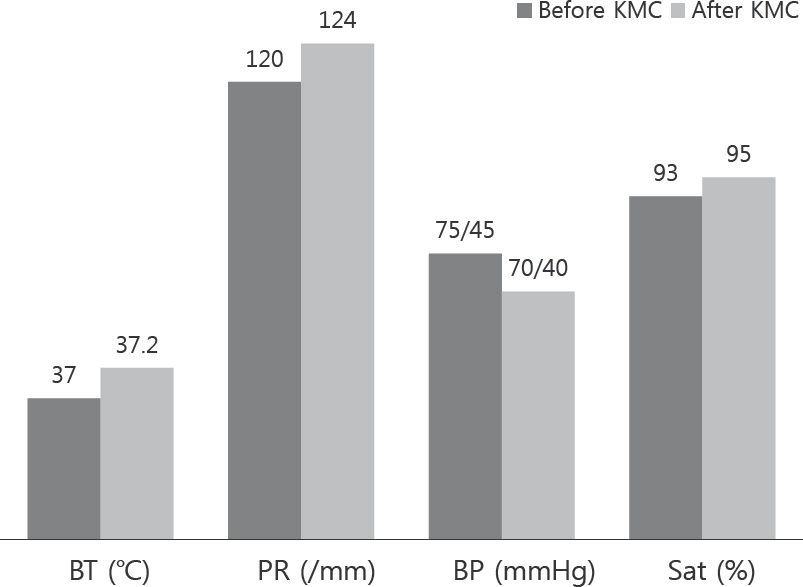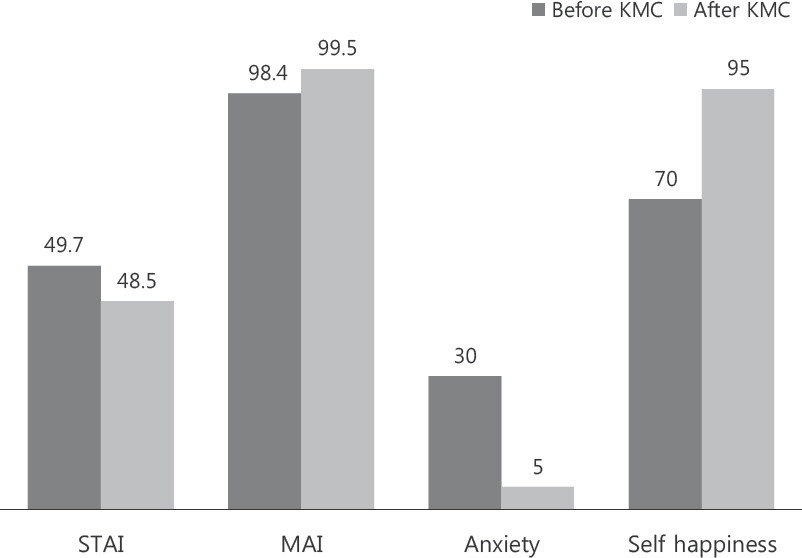Korean J Perinatol.
2015 Dec;26(4):305-311. 10.14734/kjp.2015.26.4.305.
Efficacy and Safety of Kangaroo Mother Care in Preterm Infants in Korea
- Affiliations
-
- 1Department of Pediatrics, Yonsei University College of Medicine, Seoul, Korea. SMLEE@yuhs.ac
- KMID: 2164185
- DOI: http://doi.org/10.14734/kjp.2015.26.4.305
Abstract
- PURPOSE
This study aimed to identify the safety of Kangaroo Mother Care (KMC) and to analyze its medical and psychological effects.
METHODS
Forty five preterm infants, admitted to Gangnam Severance Hospital NICU from October 2012 to September 2013, were recruited. KMC was performed for 1 hour daily until the discharge by either mother or father. The medical effects in KMC group were compared with historical control group. Psychological effects in KMC group were made a comparison with the non-KMC group.
RESULTS
The mean gestational age was 31.3+/-3.5 weeks, and the mean birth weight was 1,080+/-250 g. KMC was started at the mean age of 18.3+/-8.4 days. No event of hypothermia, bradycardia, desaturation, or hypotension occurred. There was no event of death or sepsis. Four patients (9%) had apnea but recovered after the tactile stimulation. Duration of the hospitalization in KMC group was significantly shorter than control group (P=0.041). Spielberger's anxiety scale decreased from 49.7 to 48.5. Muller's maternal attachment inventory increased from 98.4 to 99.5. Reduction of the self-happiness score improved from 5% to 70%. The score for Spielberger's anxiety scale tended to be lower in the KMC group than in the control group without statistically significant. Muller's maternal attachment inventory score was significantly higher in the KMC group.
CONCLUSION
KMC is a safe method to Korean preterm infants. Due to reduction of hospitalization and beneficial psychological effect, we believe that offering KMC to more preterm infants as a supplement therapy will be useful.
MeSH Terms
Figure
Reference
-
References
1. Rey E, Martínez H. Manejo racional del niño prematuro. Bogotá, Colombia: Universidad Nacional, Curso de Medi-cina Fetal. 1983.2. Charpak N, Ruiz-Peláez JG, Figueroa de C Z, Charpak Y. Kangaroo mother versus traditional care for newborn infants </=2000 grams: a randomized, controlled trial. Pediatrics. 1997; 100:682–8.3. Lee J, Bang KS. The Effects of Kangaroo Care on Maternal Self-esteem and Premature Infants' Physiological Stability. Korean J Women Health Nurs. 2011; 17:454–62.
Article4. Bang KS. Perception of Nurses and Physicians in Neonatal Intensive Care Units on Kangaroo Care. J Korean Acad Child Health Nurs. 2011; 17:230–7.
Article5. Engler AJ, Ludington-Hoe SM, Cusson RM, Adams R, Bahnsen M, Brumbaugh E, et al. Kangaroo care: national survey of practice, knowledge, barriers, and perceptions. MCN Am J Matern Child Nurs. 2002; 27:146–53.6. Pallás-Alonso CR, Losacco V, Maraschini A, Greisen G, Pierrat V, Warren I, et al. Parental involvement and kangaroo care in European neonatal intensive care units: a policy survey in eight countries. Pediatr Crit Care Med. 2012; 13:568–77.7. Conde-Agudelo A, Belizán JM, Diaz-Rossello J. Kangaroo mother care to reduce morbidity and mortality in low birthweight infants. Cochrane Database Syst Rev. 2011. CD002771.
Article8. Spielberger CD. Manual for the state-trait anxiety inventory. Palo Alto (CA): Consulting Psychologists Press;1983.9. Müller ME. A questionnaire to measure mother-to-infant attachment. J Nurs Meas. 1994; 2:129–41.
Article10. Charpak N, Ruiz JG, Zupan J, Cattaneo A, Figueroa Z, Tessier R, et al. Kangaroo Mother Care: 25 years after. Acta Paediatr. 2005; 94:514–22.
Article11. Jefferies AL, and the Canadian Paediatric Society, Fetus and Newborn Committee. Kangaroo care for the preterm infant and family. Paediatr Child Health. 2012; 17:141–6.12. Rangey PS, Sheth M. Comparative Effect of Massage Therapy versus Kangaroo Mother Care on Body Weight and Length of Hospital Stay in Low Birth Weight Preterm Infants. Int J Pediatr. 2014; 2014:434060.
Article13. Mendes EW, Procianoy RS. Massage therapy reduces hospital stay and occurrence of late-onset sepsis in very preterm neonates. J Perinatol. 2008; 28:815–20.
Article14. Mori R, Khanna R, Pledge D, Nakayama T. Meta-analysis of physiological effects of skin-to-skin contact for newborns and mothers. Pediatr Int. 2010; 52:161–70.
Article15. Park HK, Choi BS, Lee SJ, Son IA, Seol IJ, Lee HJ. Practical application of kangaroo mother care in preterm infants: clinical characteristics and safety of kangaroo mother care. J Perinat Med. 2014; 42:239–45.
Article16. Bloch-Salisbury E, Zuzarte I, Indic P, Bednarek F, Paydarfar D. Kangaroo care: cardiorespiratory relationships between the infant and caregiver. Early Hum Dev. 2014; 90:843–50.
Article17. Heimann K, Vaessen P, Peschgens T, Stanzel S, Wenzl TG, Orlikowsky T. Impact of skin to skin care, prone and supine positioning on cardiorespiratory parameters and thermoregulation in premature infants. Neonatology. 2010; 97:311–7.
Article18. Ohgi S, Fukuda M, Moriuchi H, Kusumoto T, Akiyama T, Nugent JK, et al. Comparison of kangaroo care and standard care: behavioral organization, development, and temperament in healthy, low-birthweight infants through 1 year. J Perinatol. 2002; 22:374–9.
Article19. Mörelius E, Örtenstrand A, Theodorsson E, Frostell A. A randomised trial of continuous skin-to-skin contact after preterm birth and the effects on salivary cortisol, parental stress, depression, and breastfeeding. Early Hum Dev. 2015; 91:63–70.
Article20. Korraa AA, El Nagger AA, Mohamed RA, Helmy NM. Impact of kangaroo mother care on cerebral blood flow of preterm infants. Ital J Pediatr. 2014; 40:83.
Article21. Feldman R, Eidelman AI, Sirota L, Weller A. Comparison of skin-to-skin (kangaroo) and traditional care: parenting outcomes and preterm infant development. Pediatrics. 2002; 110:16–26.
Article22. Bera A, Ghosh J, Singh AK, Hazra A, Mukherjee S, Mukherjee R. Effect of kangaroo mother care on growth and development of low birthweight babies up to 12 months of age: a controlled clinical trial. Acta Paediatr. 2014; 103:643–50.23. Samra NM, Taweel AE, Cadwell K. Effect of intermittent kangaroo mother care on weight gain of low birth weight neonates with delayed weight gain. J Perinat Educ. 2013; 22:194–200.
Article24. Lai HL, Chen CJ, Peng TC, Chang FM, Hsieh ML, Huang HY, et al. Randomized controlled trial of music during kangaroo care on maternal state anxiety and preterm infants' responses. Int J Nurs Stud. 2006; 43:139–46.
Article25. Ahn HY, Lee J, Shin HJ. Kangaroo care on premature infant growth and maternal attachment and postpartum depression in South Korea. J Trop Pediatr. 2010; 56:342–4.
Article26. Tessier R, Cristo M, Velez S, Giron M, de Calume ZF, Ruiz-Palaez JG, et al. Kangaroo mother care and the bonding hypothesis. Pediatrics. 1998; 102:e17.
Article
- Full Text Links
- Actions
-
Cited
- CITED
-
- Close
- Share
- Similar articles
-
- Physiological Effects of Kangaroo Care(skin-to-skin care) in Small Preterm Infants and Their Parents
- Kangaroo mother care practices for low birthweight newborns in a district hospital in Indonesia
- Perception and Barriers to Kangaroo-Mother Care Among Neonatal Intensive Care Unit Nurses
- The Effect of Fathers' Kangaroo Care Experience of Preterm Babies on Paternal Attachment
- The Effects of Kangaroo Care on Anxiety and Confidence and Gratification of Mothering Role in Mothers of Low Birth Weight Infants



